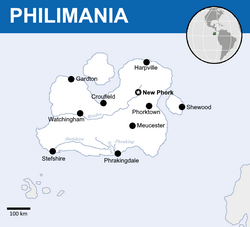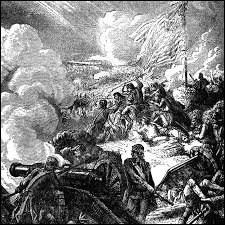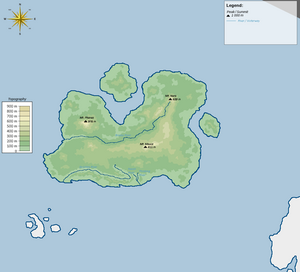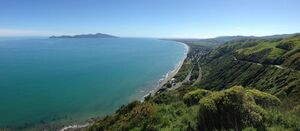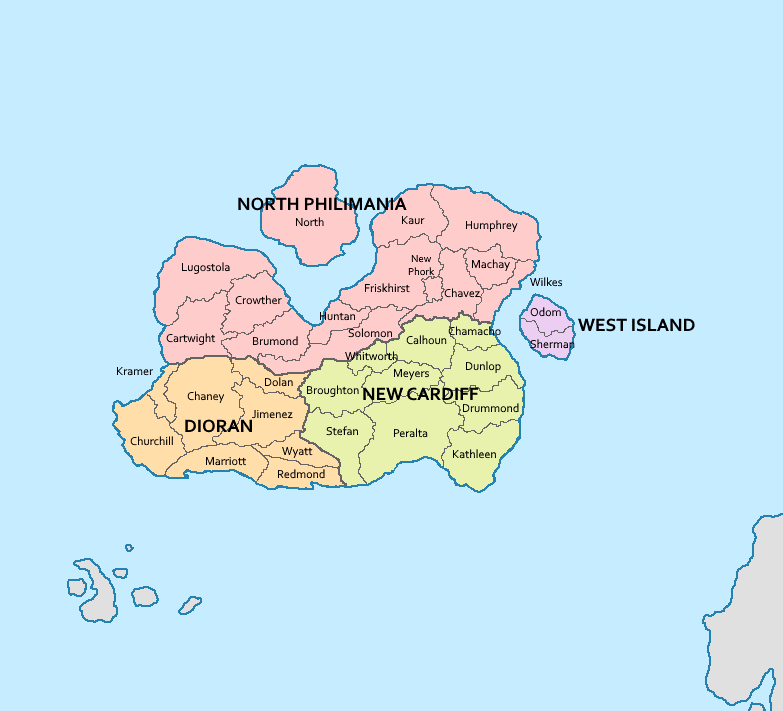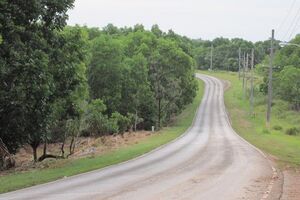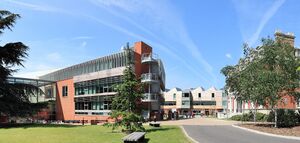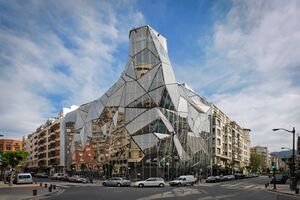Philimania: Difference between revisions
| Line 169: | Line 169: | ||
[[File:Geography map.png|thumb|Physical map of Philimania]] | [[File:Geography map.png|thumb|Physical map of Philimania]] | ||
The land area of Philimania is 228,500 km² (88,200 sq mi) and is bordered by the {{wp|Pacific Ocean}} on all sides. Philimania is 150.3 kilometres (93.4 miles) north of the {{wp|equator}} and comprises of 3 islands, Philimania, [[West Island]], and [[North Island]]. The islands is surrounded by a coral reef, which is exposed at low tide and dotted with pinnacles. The tallest point in Philimania is [[Mount Phanes]] standing at 976 meters in the West of [[North Philimania]]. The most of inland Philimania is covered by the [[Harodan Rainforest]]. [[North Island]] is mostly covered in swamp known as the [[Retop Lagoon]]. There are 4 rivers in Philimania with the longest of which is the [[Brades River]] which runs from [[Mount Naro]] to the west coast of Philimania. | |||
=== Enviroment === | |||
[[File:West Island reserve.jpg|thumb|left|The West Island Wildlife Reserve.]] | |||
Philimania has a history of strong environment conservation. For example, The northern part of the [[West Island]] are protected under the [[West Island Wildlife Preserve]], which was established in 1957. | |||
While much of Philimania remains free of environmental degradation, areas of concern include illegal {{wp|Blast fishing|dynamite fishing}}, inadequate {{wp|Waste management|solid waste disposal}} facilities in [[Dioran]] and extensive sand and coral dredging in the [[Retop Lagoon]]. | |||
=== Biodiversity === | |||
Philimania is one of eighteenth {{wp|megadiverse countries}} in the world according to Conservation International, and it has the most biodiversity per square kilometer of any nation. | |||
Philimania has 900 bird species. In addition to more than 10,000 species of plants, the country has 97 endemic reptiles, 138 endemic amphibians, and 4,000 species of butterfly. As of the writing of the plan in 2005, 12% of Philimania's land area was in a protected area; however, the plan also states that 35% of the land must be protected in order to truly preserve the nation's biodiversity. Current [[List of Protected Areas in Philimania|protected areas]] include 10 national parks, 12 wildlife refuges, 7 ecological reserves, and other areas. | |||
=== Climate === | === Climate === | ||
Philimania experiences a humid tropical climate with generally cool temperatures and plentiful rainfall all year round. | Philimania experiences a humid tropical climate with generally cool temperatures and plentiful rainfall all year round. Because of the nations close proximity at the equator, Philimania experiences little variation in daylight hours during the course of a year. Both sunrise and sunset occur each day at the two six o'clock hours. | ||
The temperature in Philimania ranges between 30 and 35 °C (86 and 95 °F) at the coast and 30 and 31 °C (86 and 87.8 °F) inland during the day and is quite stable at around 24 °C (75.2 °F) at night. | |||
{{Weather box|location = Philimania | {{Weather box|location = Philimania | ||
| Line 252: | Line 268: | ||
|Dec sun = 182.9 | |Dec sun = 182.9 | ||
|source 1 = Hong Kong Observatory|date=August 2010}} | |source 1 = Hong Kong Observatory|date=August 2010}} | ||
=== Administrative divisions === | === Administrative divisions === | ||
[[ | Philimania is divided into 4 provinces, [[North Philimania]], [[West Island]], [[Dioran]], and [[New Cardiff]] which are then divided into numerous counties. | ||
{| class="wikitable" style="width:808px;text-align:center;" | |||
|- | |||
!Current map | |||
|- | |||
| | |||
[[File:Philimania Provinces.png||center|frameless|800px|Provincial map of Philimania]] | |||
|- | |||
| | |||
|- | |||
|} | |||
== Transport and infrastructure == | == Transport and infrastructure == | ||
Revision as of 11:21, 10 February 2022
This article is incomplete because it is pending further input from participants, or it is a work-in-progress by one author. Please comment on this article's talk page to share your input, comments and questions. Note: To contribute to this article, you may need to seek help from the author(s) of this page. |
Republic of Philimania | |
|---|---|
| Motto: Vita Frui ("Enjoy Life") | |
| Anthem: "Toku Nuu" (English: "My Nation") | |
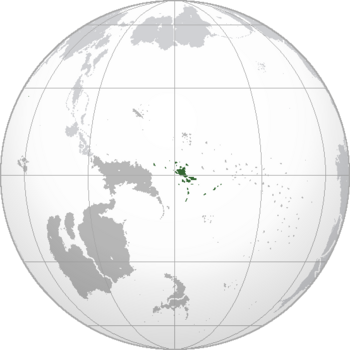 Location of Philimania (dark green) – in South America (grey) | |
| Capital | New Phork City |
| Largest city | New Phork City |
| Official languages | English |
| Recognised regional languages | Spanish |
| Ethnic groups (2021)[1] | 60% Philimanian 34% Hispanic 6% other |
| Religion |
|
| Demonym(s) | Philimanian |
| Government | Constitutional Federal Republic [2] |
| Nel Karlson | |
| Henry Field | |
| Legislature | |
| Legislative Council | |
| House of Representatives | |
| History | |
• Founding of New Cardiff | May 1603 |
• Founding of Philimania | July 1621 |
• Founding of the Legislative Council | 6 March 1654 |
• Long Kingdomian Revolt | 10 August 1768 - 15 March 1770 |
• Japanese Occupation | 17 June 1936 - 25 April 1945 |
| Area | |
• Total | 228,500[3] km2 (88,200 sq mi) |
| Population | |
• 2017 estimate | |
• 2021 census | 14,088,100 [4] |
• Density | 61.6/km2 (159.5/sq mi) |
| GDP (PPP) | 2020 estimate |
• Total | |
• Per capita | |
| GDP (nominal) | 2020 estimate |
• Total | |
• Per capita | |
| Gini | low |
| HDI | very high |
| Currency | Philimanian Dollar (P$) (PD) |
| Time zone | (GMT-6) |
| Date format | dd/mm/yyyy (CE) |
| Driving side | left |
| Calling code | +47 |
| ISO 3166 code | PH |
| Internet TLD | .ph |
The Republic of Philimania (/fɪlɪ'meɪnɪə/ ( listen)), commonly called Philimania, is a federal republic governed by The Philimanian Legislative Council (TPLC) in Western South America. Philimania covers over 20 thousand square kilometres and has a population of over 5 million. The nation consists of 4 provinces.
Settled by people from New Zealand and Polynesia circa 2000 BCE, Philimania was discovered by British and Spanish pilgrims hoping to escape persecution in the early 17th century. From 1936 to 1945, Philimania was invaded and occupied by the Japanese before being liberated by Australian and Peruvian forces on the 25th of April 1945. After World War II, Philimania became a member of the United Nations.
Philimania is a developed country, with a high national GDP of P$1.342 trillion. The per capita GDP of P$30,120 ranks highly in the world. The economy is fueled almost entirely by the private sector, which is quite specialized and led by the Tourism industry, with significant contributions from Book Publishing, Information Technology, and Arms Manufacturing. The average income is 65,825 dollars and evenly distributed, with the richest citizens earning only 2.7 times as much as the poorest. Philimania ranks highly in civil rights, political freedom, and economic freedom. Philimania is a small power, as well as a member of several international organizations, including the United Nations.
Etymology
The term 'Philimania' is believed by historian to have come from the name of the Polynesian tribe that once lived on the island.
History
Early history
Philimania was originally settled between the 3rd and 2nd millennia BCE by Polynesians most likely from New Zealand and the Central Pacific Ocean. Little is known about Philimania before the arrival of the British and Spanish, although the islands are believed to have had a long period of isolation, which accounts for the distinct language that developed among the inhabitants.
In 1520 Portugese explorer Ferdinand Megallan became the first westerner to spot the islands of Philimania, calling it 'Faira Ilha' because of its attractive appearance. However the islands were somehow never sighted again until the arrivals of the pilgrims in 1603.
In May 1603, British and Spanish pilgrims settled on what is now the modern day south coast of the province of New Cardiff. They are believed to have established the State of New Cardiff in which the city of Phrakingdale was founded. Little is known about the pilgrims lives in Philimania but is a well known that over time the British, Spanish and Polynesian on the island had merged into a new group of people known commonly today as the Philimanians. By 1620, most of the islands of Philimania were explored and settled, most commonly along the coast as inland Philimania was made of thick jungle. It is unknown how Philimania was formed, but it has been widely agreed by historians that the nation was officially established in July of 1621 when Governor Harry Liams was appointed as leader of the nation.
On the 7th of March 1634, Philimania was rediscovered by the western world when a Spanish fleet docked at the harbours of Phrakingdale. From at least 1635, Philimanians had regular contact with Europeans on whaling and trading ships who called for provisions and fresh drinking water and supplies. Eventually, a more centralized market would open up in Philimania in 1639 by the Governor of Philimania Harry Liams.
In 1654, the governor passed away and The Philimanian Legislative Council was formed as a advising body for the new governor George Williams who in 1657 renamed the position to the President of Philimania.
During the Seven Years' War, the island of Largoia, now known as Long Kingdom, was ceded from Spain to Philimania. There were protests on the streets of Largoia after the cedeing and finally on the 10th of August 1768 Largoia revolted against Philimania. The general of the Philimanian army, Keane Tomlinson, launched an all-out assault on the beaches of Largoia with insignificant losses. But in October Spain declared war on Philimania and their forces were driven off of Largoia, but not after a final stand at the Battle of Pices Beach. It was estimated that Spanish and Largoian forces suffered twice as much as the Philimanians.
By February 1769, Spanish and Long Kingdomian forces were pushing Philimanian forces onto their own island. Eventually, they reached Phorktown, where Philimania managed to kick out the invaders at the Battle of Phorktown Hill with both sides suffered heavy losses. The war ended in a stalemate but Philimania was forced to give up Largoia during the Treaty of Phorktown in March of 1770.
Pre-Japanese Era
In 1771, the city of New Phork was founded by Henry Phork to the north of Phorktown and by 1798, it was the most prosperous city in Philimania, attracting tons of people from smaller communities to come and find work which meant the city expanded and eventually becoming the cultural, financial and economic centre of Philimania. New Phork was then made the new capital in 1899 by president Mahad Sanders and The Philimanian Legislative Council was there.
Over the course of the nineteenth century, Philimania's population grew from 1.2 million to 12 million. The Great Irish Famine brought a large influx of Irish immigrants; more than 500,000 were living in Philimania by 1860. There was also extensive immigration from the German provinces, where revolutions had disrupted societies, and Germans comprised another 20% of Philimania's population by 1880.
The beginning of the Industrial Revolution in Philimania is usually pegged to the opening of a textile factory in Stefshire, Dioran, in 1802 by the recent English immigrant John Chamberlain. The Industrial Revolution in Philimania led to a boost of the production of Philimanian goods such as textile, timber, and coal. The industrialization soon led to the founding of the Philimanian Rail Company in 1847 and the construction of the Philimanian InterCity Network from May 1847 to August 1859 which sped up transportation of goods and people. In 1911, the Phorktown Subway opened, making Philimania the first nation in South America to do so.
Japanese Occupation
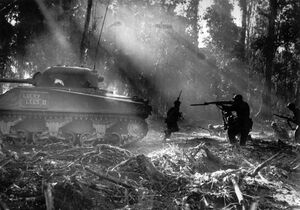
On the 18th of August 1935, the Second World War began in the Pacific with the Japanese invasion of New Guinea. After 4 months, most of the Pacific and Oceania was occupied by Japan. On the 1st of January 1936, the United States declared war on Japan after the Japanese Invasion of Hawaii in December, but by April of 1936, the United States had been nearly defeated in the Pacific with some forces retreating to Philimania. In May the same year Japan declared war on Philimania after president George Howard refused to remove US troops that had retreated to the islands. Philimania fought fiercely initally head on but after a few weeks resorted to using Guerrilla tactics after Japan had completely dominated the seas around the nation. The most deadliest battles of the invasion of Philimania was the Battle of Mount Meuce which saw around 90,000 casualties on both sides, the 2nd deadliest in the Pacific Theatre. The battle lasted for 2 days from the 3rd to 5th of June 1937. In February of 1938, New Phork was captured after a long battle forcing the Legislative Council to surrender. Despite that, the people of Philimania didn't, in February, the Philimanian Resistance was formed by a few Council members, soldiers, and civilians to continue fighting against Japanese control.
In October of 1939, Japan declared war on Peru to solidify their hold over the Southern Pacific Region leading to the involvement of Chile, Ecuador, and Argentina in the war forming what is known as the South American Alliance. In April of 1940, the Alliance broke through Japanese naval defenses with the aid of the Philimanian Resistance at the Battle of the Philimanian Sea which lasted for 26 days from the 11th of March to the 6th of April. Although Philimania would not be liberated until 1945, it was generally believed to be its first step.
Around the same time of the Battle of the Philimanian Sea, Australian forces successfully pushed through Japanese occupied Vanuatu and Fiji, eventually managing to secure Samoa, Cook Islands, French Polynesia, and the Pitcairn Islands from between April of 1940 to September 1942. In December the same year, a joint operation of the United States, Australia, and South America with the help of the Resistance to liberate Philimania and secure the surronding islands. After 3 years from December of 1942 to April of 1945, Japanese forces were kicked out of Philimania officially ending the Japanese Occupation of Philimania. After a few days, on the 30th of April, the government was restored in New Phork.
After the Second World War ended in the Pacific Theatre on the 2nd of September 1945 when the United States dropped 2 Atomic bombs on the Japanese city of Hiroshima and Nagsaki, Japan was forced to pay $5,000,000 (roughly $177,800,000 in today's money) in reparation.
Modern Era
In 1957, the West Island Wildlife Preserve was established in the northern part of the West Island to protect native animals such as the Wee-Wee Fish from poaching and the likes. From at least 1967, some InterCity railway lines were replaced with highspeed trains providing shorter timespan when travelling between cities.
On 25 November 1978, the United Nations Security Council passed Resolution 440 recommending Philimania's admission to the United Nations. The United Nations General Assembly approved admission for Philimania pursuant to on 6 December 1978.
In 1984, Foster International Airport was built by the state-owned cooperation Huton Incorporated.
Geography
The land area of Philimania is 228,500 km² (88,200 sq mi) and is bordered by the Pacific Ocean on all sides. Philimania is 150.3 kilometres (93.4 miles) north of the equator and comprises of 3 islands, Philimania, West Island, and North Island. The islands is surrounded by a coral reef, which is exposed at low tide and dotted with pinnacles. The tallest point in Philimania is Mount Phanes standing at 976 meters in the West of North Philimania. The most of inland Philimania is covered by the Harodan Rainforest. North Island is mostly covered in swamp known as the Retop Lagoon. There are 4 rivers in Philimania with the longest of which is the Brades River which runs from Mount Naro to the west coast of Philimania.
Enviroment
Philimania has a history of strong environment conservation. For example, The northern part of the West Island are protected under the West Island Wildlife Preserve, which was established in 1957.
While much of Philimania remains free of environmental degradation, areas of concern include illegal dynamite fishing, inadequate solid waste disposal facilities in Dioran and extensive sand and coral dredging in the Retop Lagoon.
Biodiversity
Philimania is one of eighteenth megadiverse countries in the world according to Conservation International, and it has the most biodiversity per square kilometer of any nation.
Philimania has 900 bird species. In addition to more than 10,000 species of plants, the country has 97 endemic reptiles, 138 endemic amphibians, and 4,000 species of butterfly. As of the writing of the plan in 2005, 12% of Philimania's land area was in a protected area; however, the plan also states that 35% of the land must be protected in order to truly preserve the nation's biodiversity. Current protected areas include 10 national parks, 12 wildlife refuges, 7 ecological reserves, and other areas.
Climate
Philimania experiences a humid tropical climate with generally cool temperatures and plentiful rainfall all year round. Because of the nations close proximity at the equator, Philimania experiences little variation in daylight hours during the course of a year. Both sunrise and sunset occur each day at the two six o'clock hours.
The temperature in Philimania ranges between 30 and 35 °C (86 and 95 °F) at the coast and 30 and 31 °C (86 and 87.8 °F) inland during the day and is quite stable at around 24 °C (75.2 °F) at night.
| Climate data for Philimania | |||||||||||||
|---|---|---|---|---|---|---|---|---|---|---|---|---|---|
| Month | Jan | Feb | Mar | Apr | May | Jun | Jul | Aug | Sep | Oct | Nov | Dec | Year |
| Average high °C (°F) | 30.6 (87.1) |
30.6 (87.1) |
30.9 (87.6) |
31.3 (88.3) |
31.4 (88.5) |
31.0 (87.8) |
30.6 (87.1) |
30.7 (87.3) |
30.9 (87.6) |
31.1 (88.0) |
31.4 (88.5) |
31.1 (88.0) |
31.0 (87.7) |
| Daily mean °C (°F) | 27.3 (81.1) |
27.2 (81.0) |
27.5 (81.5) |
27.9 (82.2) |
28.0 (82.4) |
27.6 (81.7) |
27.4 (81.3) |
27.5 (81.5) |
27.7 (81.9) |
27.7 (81.9) |
27.9 (82.2) |
27.7 (81.9) |
27.6 (81.7) |
| Average low °C (°F) | 23.9 (75.0) |
23.9 (75.0) |
24.1 (75.4) |
24.4 (75.9) |
24.5 (76.1) |
24.2 (75.6) |
24.1 (75.4) |
24.3 (75.7) |
24.5 (76.1) |
24.4 (75.9) |
24.4 (75.9) |
24.2 (75.6) |
24.2 (75.6) |
| Average rainfall mm (inches) | 271.8 (10.70) |
231.6 (9.12) |
208.3 (8.20) |
220.2 (8.67) |
304.5 (11.99) |
438.7 (17.27) |
458.2 (18.04) |
379.7 (14.95) |
301.2 (11.86) |
352.3 (13.87) |
287.5 (11.32) |
304.3 (11.98) |
3,758.3 (147.97) |
| Average rainy days | 19.0 | 15.9 | 16.7 | 14.8 | 20.0 | 21.9 | 21.0 | 19.8 | 16.8 | 20.1 | 18.7 | 19.9 | 224.6 |
| Mean monthly sunshine hours | 198.4 | 194.9 | 244.9 | 234.0 | 210.8 | 168.0 | 186.0 | 176.7 | 198.0 | 179.8 | 183.0 | 182.9 | 2,357.4 |
| Source: Hong Kong Observatory | |||||||||||||
Administrative divisions
Philimania is divided into 4 provinces, North Philimania, West Island, Dioran, and New Cardiff which are then divided into numerous counties.
| Current map |
|---|
Transport and infrastructure
Foster International Airport in New Phork provides scheduled direct flights with Guam, Manila, Hong Kong, Lima, Brasília, and Taipei.
Freight, military and cruise ships often call at Phrakingdale Harbor, Gardton Harbour, or Harpville Harbour. The country has a railway that connects all the major cities. Philimania has around 1626 km or 1010.35 mi of highways, only 456 km or 283.3 mi are paved. Driving is on the left and the speed limit is 100 km/h (62 mph).
The railroad network of Philimania is 1626 km long and is traversed daily by up to 30,000 passenger and cargo trains. The partially state-owned largest railroad company Philimanian Rail Company serves and oeprates a large number of trains, passengers and infrastructure components. Most of the railroad infrastructure is maintained, operated and financed by the Ministry of Infrastructure since 1964. The network is used by regular and high speed trains, most notably the InterCity trains travelling at between 240 km/h (149 mph) to under 370 km/h (230 mph), providing expansive domestic and international rail connections. Confined urban underground rapid transit such as the New Phork Undergound, and shuttle services are all well developed in major Philimanian cities.
Demographics
Philimania has an estimated population of over 7 million of whom 60% are Philimanians, 34% are Hispanic, and 6% are other races.. While the birthrate is only 5 per 1000, the population growth rate is 5%, the result of immigration from places such as South Africa, Ireland, and China.
Language
English is the de facto national language. Approximately 90% of the population speaks English as a first language, with another 9% speaking Spanish as a first language. The third most dominant language is French, with 1% of the population being native speakers.
Religion
The majority of Philimania's population identifies as Christian. 57% identify as Protestant, with 29% identifying as Catholics. The nonreligious account for 10% of the population, while Jews make up 2.1%. All other faiths collectively make up 1.9% of the population. The 6th Amendment of Philimania guarantees religious freedom and prevents legislation that favours any religion over another. In addition, discrimination based on religion is illegal, with the exception of explicitly religious organizations such as churches.
Health
The Philimanian universal healthcare system is highly developed, as indicated by its very low infant mortality rate of 3.6 boys and 3.3 girls per 1,000 births and a high life expectancy of around 80.05 years, 79.72 years for men and 81.94 years for women.
Largest Cities
Philimania is a highly urbanized country. Its largest cities include New Phork, Phorktown, Stefshire, Shewood, Croufield, Meucester, Phrakingdale, Watchingham, Harpville, and Gardton features a number of large metropolitan areas summing up urban agglomerations, such as the Greater New Phork.
Largest cities or towns in Philimania
2020 census | |||||||||
|---|---|---|---|---|---|---|---|---|---|
| Rank | Province | Pop. | Rank | Province | Pop. | ||||
 New Phork  Phorktown |
1 | New Phork | North Philimania | 3,965,900 | 11 | Bridging | West Island | 191,784 |  Stefshire  Shewood |
| 2 | Phorktown | New Cardiff | 2,103,200 | 12 | Seerno | Dioran | 125,549 | ||
| 3 | Stefshire | Dioran | 1,320,190 | 13 | Lensaw | New Cardiff | 92,040 | ||
| 4 | Shewood | West Island | 993,742 | 14 | Henton | Dioran | 52,443 | ||
| 5 | Croufield | North Philimania | 873,427 | 15 | Reddingham | North Philimania | 30,225 | ||
| 6 | Meucester | New Cardiff | 606,854 | 16 | Zeddville | North Philimania | 25,268 | ||
| 7 | Phrakingdale | New Cardiff | 454,471 | 17 | Newton | North Philimania | 19,945 | ||
| 8 | Watchingham | North Philimania | 432,938 | 18 | Esterham | New Cardiff | 15,342 | ||
| 9 | Harpville | North Philimania | 225,647 | 19 | Tishter | Dioran | 14,050 | ||
| 10 | Gardton | North Philimania | 206,769 | 20 | Erding | West Island | 12,980 | ||
Government
The Republic of Philimania is a constitutional federal republic. The Philimanian Constitution is the supreme law of the land and closely models the US Constitution on which it was inspired. The citizens of Philimania are subject to three levels of government: federal, provincial, and local.
Local Government: Administers police and fire forces, as well as other public works. Protects private property rights.
Regional Government: Responsible for education, infrastructure, and taxation.
Federal Government: Responsible for national defence, foreign policy, and guarantees basic human rights that the provincial or local government cannot override. It is also responsible for regulating international commerce. Since 1986, the Department of Science has been responsible for coordinating and funding scientific research into a wide array of fields, notably nuclear power and weaponry, space technology, and renewable energy.
The federal government is composed of three branches:
Executive: Headed by the President of Philimania. Can veto legislative bills, appoint cabinet members and Supreme Court Justices.
Legislative: Made up of the Legislative Council and the House of Representatives. Makes federal law, declares war, allocates federal funds and approves treaties.
Judicial: Made up of the Supreme Court and lower federal courts. Has the power of judicial review, and is the highest legal authority after the Constitution.
Foreign Relations
As a sovereign nation, Philimania conducts its own foreign relations. Since 1700, Philimania has established diplomatic relations with a number of nations, including many of its Pacific neighbors, like Micronesia and Australia. On 25 November 1978, the United Nations Security Council passed Resolution 440 recommending Philimania's admission to the United Nations. The United Nations General Assembly approved admission for Philimania pursuant to on 6 December 1978. Philimania has since joined several other international organizations.
In international politics, Philimania often votes with Peru on United Nations General Assembly resolutions.
Philimania has maintained close ties with Brazil, which has funded infrastructure projects including the West Island Wildlife Preserve.
Philimania is a member of the Nauru Agreement for the Management of Fisheries.
Peru, a neighboring ally of Philimania to the east, has expressed its intent to back Philimania if ever it wishes to join the Union of South American Nations.
Military
With the exception of The Seven Years War and the Long Kingdomian Revolution, Philimania has been officially neutral in all armed conflicts since its founding.
The total Philimanian Armed Forces spending in 2021 is 44.2 Billion.
The commander-in-chief of the Philimanian military is Muskaan Velasquez, who is head of the Ministry of Defense. The military is divided into three branches: the Army, Air Force, the Navy, and the Marines. All of these branches serve professionally and have no other occupation. Conscription is illegal under the Philimanian Constitution.
Economy
Philimania has a GDP of P$1.342 trillion and a GDP per capita of P$30,120. The nation operates under a system of free-market capitalism. The private sector is estimated to constitute 91% of the economy, with federal, regional, and local government accounting for 8.1%. Unemployment is at 0%, largely due to excellent employment regulations throughout the country.
Philimania's economy consists primarily of tourism, subsistence agriculture and fishing. Tourist activity focuses on scuba diving and snorkeling in the islands' rich marine environment, Business and tourist arrivals numbered some 70,000 in 2014.
Philimania has a GDP of P$1.342 trillion and a GDP per capita of P$30,120. The nation operates under a system of free-market capitalism. The private sector is estimated to constitute 91% of the economy, with federal, regional, and local government accounting for 8.1%. Unemployment is at 0%, largely due to excellent employment regulations throughout the country. Long-term prospects for the key tourist sector have been greatly bolstered by the expansion of air travel in the Pacific.
Air service has at times been spotty. Philimania Air, and AirAsia provided service to Ecuador and other destinations at various times during the 2010s.
The income tax has three brackets with progressive rates of 9.3 percent, 15 percent, and 19.6 percent respectively. Corporate tax is four percent, and the sales tax is zero. There are no property taxes.
Major tourist draws in Philimania include New Phork, Phorktown, and Philimania's various museums.
Philimania is one of the world's largest exporter of tropical fruits. Australia is its top trading partner, followed by The United States, China, The United Kingdom and Japan.
Culture
Philimania is home to a variety of cultures, a result of a liberal immigration policy. Philimanian culture is generally considered Western, derived from traditions of European and Polynesian culture. There are also large Hispanic and Afro-Ecuadorian populations. Like other American nations, Philimania has been described as a melting pot where several cultures join into one.
Philimanians have been described as very compassionate, hard-working, and competitive. This has resulted in great economic productivity and a libertarian form of government. This has also made Philimania a popular destination for immigrants. Philimanians are also firm believers in equality and do not think that one social class should have more rights than others.
Cuisine
Mainstream Philimanian cuisine is similar to that in Pacific cultures. Philimania is also famous for its Polynesian cuisine. The Wee-Wee Fish, an important part of Philimanian cuisine, is a major agricultural export of Philimania. Philimanian cuisine features dishes such as pineapple pie, Philimanian curry, panipopo, and coconut cake.
Sports
Philimania's market for professional sports is roughly P$16 billion. While the most popular spectator sport is football (soccer), the national sport is considered to be Basketball. Philimanian athletes have set several world records and won 340 Olympic medals in athletics alone. Philimania also hosted the 2018 FIFA World Cup. In addition, the 2000 Olympic Games were held in Phorktown. Hockey, baseball, and tennis are also popular sports.
Education
Primary education is required until the age of 16. Schools include both public and private institutions as well as some fields of study available at Philimania Community College. For further undergraduate, graduate and professional programs, students would attend tertiary institutions. Popular choices among Philimanian scholars include the University of New Phork, International University of Philimania, Gapan University, and Oton University.
Architecture
The architecture of Philimania is a mixture of Polynesian, English, North American, modern, and postmodern architecture mix. Philimania's notable buildings were built around the 18th and early 19th centuries. These buildings were designed in a number of styles – Mock Tudor, Neo-Gothic or Grecian-Spanish style architecture. Most of the styling has been modified to use local resources and acclimatised to the local climate, which is tropical and humid all year around.
Late modern and postmodern architecture began to appear in the earky-1960s and early-1980s. With the economic development, old buildings have been razed to make way for new ones. Buildings with all-glass shells exist throughout the city, with the most prominent examples being the Admira Centre in Phorktown.
Social Media
In Philimania, social media is part of everyday life of almost every Philimanian. A survey in 2019 shows that more than 88% of the population uses social media sites such as Facebook, Twitter, Instagram and others, mostly used for interacting with other users local or abroad, empowering businesses and enterprises and also used by the state to broadcast its announcements such as natural disasters, new laws and decrees and also news on social media. However, there are some reports that the social media in Philimania is prone to Cybercrimes such as objectification of women, cyberbullying, troll accounts, and scams. In response, Philimania has its own Social Media Regulation Board to enforce laws to users using social media. Censorship isn't observed in much of social media sites in Philimania and almost every social media site is accessible in the state.



